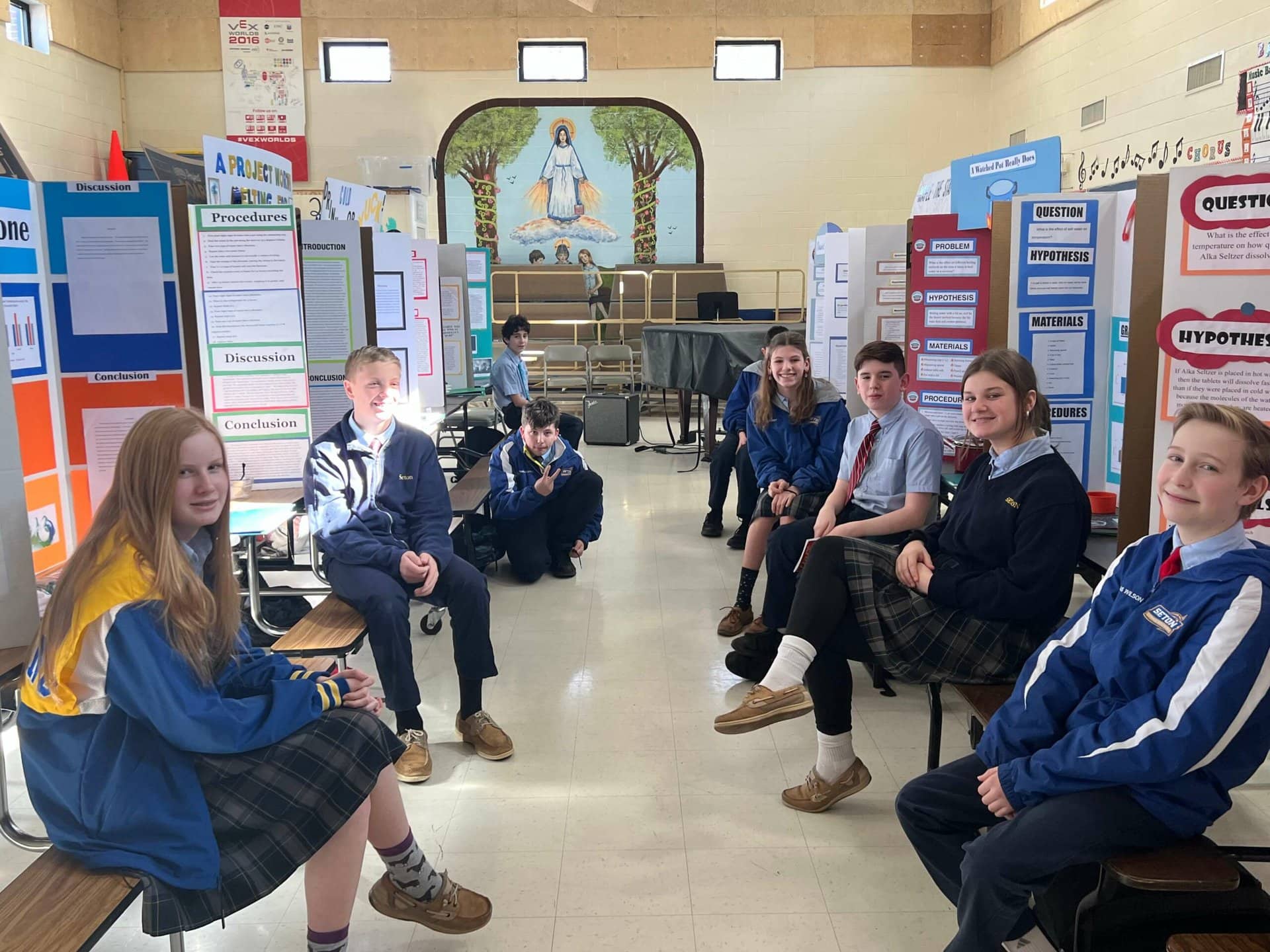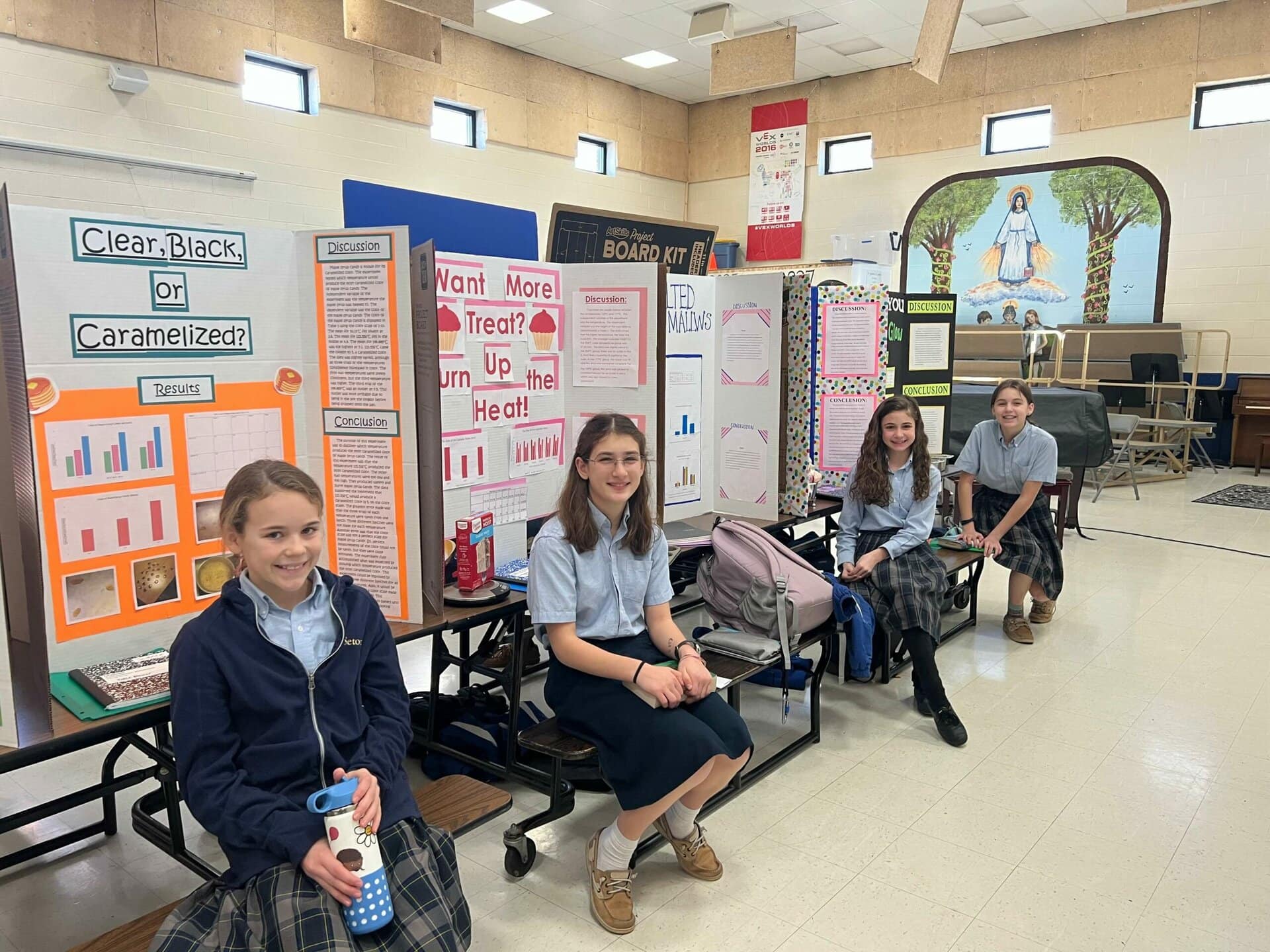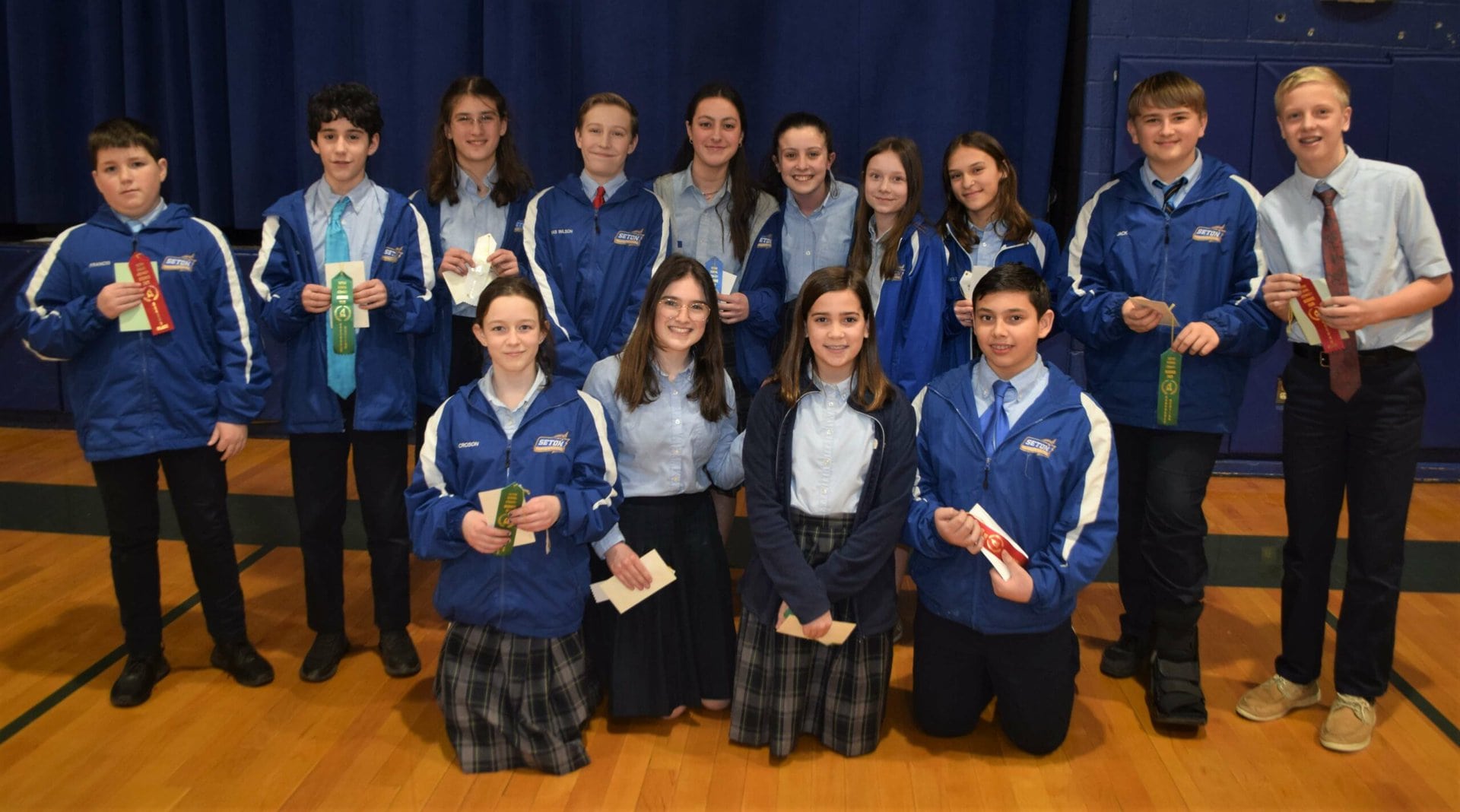Seton Science Fair
Seton School participates in a Science Fair every year. Both junior and senior high students participate. All 7th grade students and High School students that are taking Biology participate in the Science Fair. Those students that transfer into Seton and have already taken Biology still are required to participate in the Science Fair in order to graduate. Both the Life Science and Biology classes focus a lot of time preparing for the Science Fair.
Seton School has traditionally chosen to run its science fair in keeping with both the Prince William County Regional Science Fair and the INTEL International Science and Engineering Fair. Therefore, all projects and paperwork, as well as deadlines are completed with this in mind. The Seton Science Fair will be held in January, one day for Junior High and another day for High School.
Students should aim to finish their projects by Thanksgiving and before the Christmas holiday.
Overview of Forms and Dates
The ISEF forms constitute written documentation of what will occur, or in some cases, has already occurred, in a research project. They are designed to provide the information that is needed to review the project to ensure compliance with the ISEF rules and with laws and regulations that apply to the project. The forms should be filled out and signed before any research takes place. (Only Forms 1C, 5B, 7, and the abstract are done after the research.) The dates of the signatures reflect when the approval or consent is given. Use MM/DD/YY format for all dates.
Checklist for Adult Sponsor (1)
The checklist is provided so that the adult sponsor can review what information (and therefore which forms) must be provided. The date signed is the date that the sponsor first reviews the project plan before the experiment begins.
Student Checklist (1A)
On this page, the student outlines what the project is about. Items that especially need to be clear are the following:
#6 Any project conducted in a similar area of research as previous projects should be considered a continuation. If the project is a continuation, explain on Form 7 as completely as possible how the project will differ from previous experimentation because ONLY a new and different research project is allowed. The current year project must demonstrate significant progress.
#7 Explain when the actual experimental procedure (not the background literature review) will begin and end because ONLY a 12-month project that occurred within the last 18 months before this ISEF is allowed.
#8 Explain where the experimental research will be done: research institution, school, field, home. Universities, research facilities, and industrial settings will require additional documentation on Form 1C to explain what was done at each facility. (Note: Pathogens may NOT be cultured at home.)
#10 Attach a Research Plan and Project Summary, as outlined in the Research Plan and Summary Instructions, which describes the project in detail and answers all applicable questions.
Approval Form (1B)
These statements attest that each of these people (or committees) approves or consents to this project. The dates should be signed as described below and are before experimentation unless otherwise indicated:
| a) Student | Date they attest that they understand the possible risks, that they have read and will follow the rules, and that they will abide by the ethics statement. | |
| b) Parent/Guardian | Date they consent to their child doing this project. | |
| c) SRC Approval BEFORE | Date that the committee reviews this project BEFORE the experimentation. Projects that must be preapproved are research in these areas: human participants, vertebrate animals, and PHBA’s (potentially hazardous pathogenic agents) including microorganisms, recombinant DNA, and human or animal tissue. | |
| d) SRC Approval AFTER | This applies only to projects that needed preapproval by the SRC but were done at a research institution and were preapproved by that institution instead of the affiliated fair SRC. The date signed indicates when the SRC approved this project after it was completed. All documentation from the research institution showing approval of the project must be attached. | |
| e) Final SRC Approval | All projects must be reviewed by the SRC after the experimentation is complete and shortly BEFORE competition in the affiliated fair. The date signed shows the date that SRC gives final approval to this project. |
Regulated Research Institution (1C)
This form is completed by the supervising adult, explains what the student researcher actually did and is signed after the project is completed. This form is only needed if the research was done at a research institution (university lab, for example) or in an industrial setting, but is not completed for work done at a high school.
Qualified Scientist (2)
On this page, the scientist explains what will be done to oversee this project. The qualified scientist (QS) and, if needed, the designated supervisor (DS), will sign with the date that they approve this project (before experimentation takes place).
Risk Assessment Form (3)
Required for projects using hazardous chemicals, activities or devices, and some PHBA’s including protists, composting, coliform test kits, decomposition of vertebrate organisms and microbial fuel cells and must be completed and signed by the DS or QS prior to student experimentation.
Human Participant Form (4)
This page, along with the research plan, is submitted by the student researcher to explain to the IRB how the safety and well being of the test subjects and the confidentiality of results will be ensured. The IRB reviews the project, checks the risk level and determines if written documentation of assent/consent/permission is required. All questions must be answered and boxes checked. Each IRB member signs with the date they approve this project. This review and the date signed must be BEFORE any experimentation takes place.
When required by the IRB, a written informed assent/consent/parental permission form is used to explain to the research participant and their parent/guardian the risks and benefits associated with participation. (See Human Informed Consent Form.) Questionnaires, sample tests, etc. MUST be given to the IRB and to the parent/guardian. If the participant wishes to participate and when required, the parent/guardian also agrees, they each sign the Informed Consent Form with the date that they approve. (Before experimentation begins).
Vertebrate Animal Form (5A)
This form is filled out by the student researcher when the experiment is conducted in a Non-Regulated Research Site such as home or school and describes the housing and care for the animals. The SRC reviews this document and determines the level of supervision required for the study and signs and dates BEFORE experimentation begins. The bottom of the form is filled out by the veterinarian and/or designated supervisor and is signed and dated when they approve this project with these housing conditions. (Before experimentation begins.)
If there was any illness, unexpected weight loss or death of an animal during the experimentation, the cause must be investigated and a letter from the Qualified Scientist, Designated Supervisor, or a veterinarian which documents the situation and the results of the investigation must be attached.
Vertebrate Animal Form (5B)
This form is filled out by the Qualified Scientist when the research is conducted at a Regulated Research Institution and describes the study. A copy of the IACUC approval (not a letter from the Qualified Scientist or Principal Investigator) must be attached.
If there was any weight loss or death of an animal during the experimentation, the cause must be investigated and a letter from the Qualified Scientist, Designated Supervisor, or a veterinarian which documents the situation and the results of the investigation must be attached.
Potentially Hazardous Biological Agents (6A)
This form is filled out by the student researcher and is required for all research involving microorganisms, rDNA and fresh/frozen tissue (including primary cell lines, human and other primate established cell lines and tissue cultures), blood, blood products, and body fluids. SRC/IACUC/IBC/RAC approval required BEFORE experimentation. The qualified scientist will sign and date. The SRC will choose one or more statements that describe the approval process for the study and will add the date that approval occurred.
Human & Vertebrate Animal Tissue (6B)
This form is filled out by the student researcher and explains the source of the tissue. The Qualified Scientist or Designated Supervisor signs and dates to document the source and handling of this tissue (before experimentation).
Continuation Projects Form (7)
If the current project is in a similar area of research as any previous project of the student or any team member, it is considered a continuation. Explain as completely as possible how the project is different from previous experimentation because ONLY a new and different research project is allowed. The date signed is the date the student researcher is certifying that this information is correct.
Abstract
The abstract is a summary of the study and is written after experimentation. ISEF finalists must use the on-line system. Regional and local fairs may use the Adobe® Acrobat® file found in the forms section of the ISEF website.
ISEF General Rules and Guidelines
International rules for pre-college science research
The 2020 International Rules are applicable for the International Science and Engineering Fair 2020 to be held in Anaheim, California, May 10-15, 2020.
The International Rules for Pre-college Science Research: Guidelines for Science and Engineering Fairs are published annually to support students doing independent research safely. They are the official rules of the ISEF and students competing at a Society-affiliated science fair.
The purpose of these rules is to:
- protect the rights and welfare of the student researcher
- protect the rights and welfare of the human participant
- ensure adherence to federal regulations
- ensure use of safe laboratory practices
- protect the environment
- determine eligibility for competition in the ISEF 2020
For rules questions, please contact the ISEF Scientific Review Committee at [email protected].
Rules for All Projects
Ethics Statement
Student researchers, as well as adults who have a role in their projects, are expected to maintain the highest ethical standards. These include, but are not limited to:
- Integrity. Honesty, objectivity, and avoidance of conflicts of interest are expected during every phase of the research. The project should reflect independent research done by the student(s), and represent only one year’s work.
- Legality. Compliance with all federal, country, state and local laws is essential. All projects must be approved by a Scientific Review Committee (SRC), and when necessary must also be approved by an Institutional Review Board (IRB), Institutional Animal Care and Use Committee (IACUC), and/or Institutional Biosafety Committee (IBC).
- Respect for Confidentiality and Intellectual Property. Confidential communications, as well as patents, copyrights, and other forms of intellectual property must be honored. Unpublished data, methods, or results may not be used without permission, and credit must be given to all contributions to research.
- Stewardship of the Environment. It is the responsibility of the researcher(s) and the adults involved to protect the environment and its organisms from harm. All projects involve some amount of risk. Everyone is expected to recognize the hazards, assess the risks, minimize them, and prepare for emergencies.
- Animal Care. Proper care and respect must be given to vertebrate animals. The guiding principles for the use of animals in research includes the following “Four R’s”: Replace, Reduce, Refine, Respect.
- Human Participant Protection. The highest priority is the health and well-being of the student researcher(s) and human participants.
- Potentially Hazardous Biological Agents (PHBAs). It is the responsibility of the student and adults involved in the project to conduct and document a risk assessment, and to safely handle and dispose of organisms and materials.
Scientific fraud and misconduct are not condoned at any level of research or competition. This includes plagiarism, forgery, use or presentation of other researcher’s work as one’s own and fabrication of data. Fraudulent projects will fail to qualify for competition in affiliated fairs and ISEF. Society for Science and the Public reserves the right to revoke recognition of a project subsequently found to have been fraudulent.
Eligibility/Limitations
- Each Intel ISEF-affiliated fair may send to Intel ISEF the number of projects provided by their affiliation agreement.
2. A student must be selected by an Intel ISEF-affiliated fair, and meet both of the following:
- a. be in grades 9-12 or equivalent; and
- b. not have reached age 20 on or before May 1 preceding the Intel ISEF.
- English is the official language of the Intel ISEF. Student project boards and abstracts must be in English.
- Each student is only allowed to enter one project. That project may include no more than 12 months of continuous research and may not include research performed before January 2018.5.Team projects must have no more than three members. Teams competing at Intel ISEF must be composed of members who all meet Intel ISEF eligibility.
6. Students may compete in only one Intel ISEF affiliated fair, except when proceeding to a state/national fair affiliated with the Intel ISEF from an affiliated regional fair.
7. Projects that are demonstrations, ‘library’ research or informational projects, ‘explanation’ models or kit building are not appropriate for the Intel ISEF.
8. All sciences (physical, life, social) are represented at the Intel ISEF. Review a complete list of categories and sub-categories with definitions.
9. A research project may be a part of a larger study performed by professional scientists, but the project presented by the student must be only their own portion of the complete study.
Requirements
General
- All domestic and international students competing in an ISEF-affiliated fair must adhere to all rules as set forth in this document.
- All projects must adhere to the Ethics Statement above.
- It is the responsibility of the student and the Adult Sponsor to evaluate the study to determine if the research will require forms and/or review and approval prior to experimentation.
- Projects must adhere to local, state and U.S. Federal laws, regulations and permitting conditions. In addition, projects conducted outside the U.S. must also adhere to the laws of the country and jurisdiction in which the project was performed.
- The use of non-animal research methods and alternatives to animal research are strongly encouraged and must be explored before conducting a vertebrate animal project.
- Introduction or disposal of non-native, genetically-altered, and/or invasive species (e.g. insects, plants, invertebrates, vertebrates), pathogens, toxic chemicals or foreign substances into the environment is prohibited. It is recommended that students reference their local, state or national regulations and quarantine lists.
- Projects competing at ISEF must have an exhibit that adheres to ISEF Display & Safety requirements and is visible during all operable hours of the exhibit hall without reliance on electricity or internet connections.
- All projects must adhere to the requirements of the affiliated fair(s) in which it competes to qualify for participation in ISEF. Affiliated fairs may have additional restrictions or requirements. Knowledge of these requirements is the responsibility of the student and Adult Sponsor.
Approval and Documentation
- Before experimentation begins, a local or regional Institutional Review Board (IRB) or Scientific Review Committee (SRC) associated with the ISEF-affiliated fair must review and approve most projects involving human participants, vertebrate animals, and potentially hazardous biological agents. Note: If a project involves the testing of a student designed invention, prototype or concept by a human, an IRB review and approval may be required prior to experimentation. See Human Participants Rules for details.
- Every student must complete the Student Checklist (1A), a Research Plan/Project Summary and Approval Form (1B) and review the project with the Adult Sponsor in coordination with completion by the Adult Sponsor of the Checklist for Adult Sponsor (1).
- A Qualified Scientist is required for all studies involving Biosafety Lab-2 (BSL-2) potentially hazardous biological agents and DEA-controlled substances and is also required for many human participant studies and many vertebrate animal studies.
- After initial IRB/SRC approval (if required), any proposed changes in the Student Checklist (1A) and Research Plan/Project Summary must be re-approved before laboratory experimentation/data collection resumes.
- Projects which are continuations of a previous year’s work and which require IRB/SRC approval must undergo the review process with the current year ResearchPlan/Project Summary prior to experimentation/data collection for the current year.
- Any continuing project must document that the additional research is new and different. (Continuation/Research Progression Projects Form (7)).
- If work was conducted in a regulated research institution, industrial setting or any work site other than home, school or field at any time during the current ISEF project year, the Regulated Research Institutional/Industrial Setting Form (1C) must be completed and displayed at the project booth.
- After experimentation, each student or team must submit a (maximum) 250-word, one-page abstract which summarizes the current year’s work. The abstract must describe research conducted by the student, not by the supervising adult(s).
- A project data book and research paper are not required, but are strongly recommended for judging purposes. Regional or local fairs may require a project data book and/or a research paper.
Page 4 International Rules: Guidelines for Science and Engineering Fairs 2019 – 2020, societyforscience.org/ISEF2020 - All signed forms, certifications, and permits must be available for review by all regional, state, national and international affiliated fair SRCs in which the student(s) participate. This review must occur after experimentation and before competition.
Continuation/ Research Progression of Projects
- As in the professional world, research projects may build on work performed previously. A valid continuation project is a sound scientific endeavor. Students will be judged only on laboratory experiment/data collection performed over 12 continuous months beginning no earlier than January 2019 and ending May 2020.
- Any project based on the student’s prior research could be considered a continuation/research progression project. These projects must document that the additional research is a substantive expansion from prior work (e.g. testing a new variable or new line of investigation). Repetition of previous experimentation with the same methodology and research question, even with an increased sample size, is an example of an unacceptable continuation.
- The display board and abstract must reflect the current year’s work only. The project title displayed in the finalist’s booth may mention years (for example, “Year Two of an Ongoing Study”). Previous year’s databooks, research papers and supporting documents may be at the booth if properly labeled as such.
- Longitudinal studies are permitted as an acceptable continuation under the following conditions:
- a. The study is a multi-year study testing or documenting the same variables in which time is a critical variable. (Examples: Effect of high rain or drought on soil in a given basin, return of flora and fauna in a burned area over time.)
- b. Each consecutive year must demonstrate time-based change
- c. The display board must be based on collective past conclusionary data and its comparison to the current year data set. No raw data from previous years may be displayed.
- All projects must be reviewed and approved each year and forms must be completed for the new year.
- NOTE: For competition in ISEF, the Continuation Research Progression Project Form (7) is required for projects in the same field of study as a previous project. This form must be displayed at the project booth. Retention of all prior years’ paperwork is required and must be presented to the ISEF SRC upon request.
Team Projects
- Team projects compete and are judged in the category of their research at ISEF. All team members must meet the eligibility requirements for ISEF.
- Teams must have no more than three members. A team with members from different geographic regions may compete at an affiliated fair of one of its members, but not at multiple fairs. However, each affiliated fair holds the authority to determine whether teams with members outside of a fair’s geographic territory are eligible to compete, understanding that if the team wins the right to attend ISEF, all team members’ expenses must be supported by the fair.
- a. Team membership cannot be changed during a given research year unless there are extenuating circumstances and the local SRC reviews and approves the change, including converting a team project to an individual project or vice versa. Such conversions must address rationale for the change and include a clear delineation between research preceding the change and that which will follow. A memorandum documenting this review and approval should be attached to Form 1A.
- b. Once a project has competed in a science fair at any level, team membership cannot change and the project cannot be converted from an individual project to a team project or vice versa.
- c. In a future research year, any project may be converted from an individual to a team project, from a team to an individual project and/or have a change in team membership.
- Each team is encouraged to appoint a team leader to coordinate the work and act as spokesperson. However, each member of the team should be able to serve as spokesperson, be fully involved with the project, and be familiar with all aspects of the project. The final work should reflect the coordinated efforts of all team members and will be evaluated using the same judging criteria as individual projects.
- Each team member must submit an Approval Form (1B). Team members must jointly submit the Checklist for Adult Sponsor (1), one abstract, a Student Checklist (1A), a Research Plan/Project Summary and other required forms.
- Full names of all team members must appear on the abstract and forms.
Frequently Asked Questions
When can I begin experimenting?
Where do I turn in my research plan and other paperwork to get pre-approval for my project?
What is the difference between a Scientific Method Project and an Engineering Design Project?
Engineering Design Projects are a modification of the above. The need for construction of a particular structure / machine is defined, and Design Criteria are established. After constructing a prototype, the effectiveness of the model is tested (using the SCIENTIFIC METHOD of experimentation). Engineering Design projects can be classified in ANY of the listed project categories (including ENGINEERING categories).
How do I determine if a chemical is hazardous?
How do I determine the "start date" of my project?
How can I determine if my laboratory is a BSL 1 or BSL 2 laboratory?
The criteria are available for ISEF affiliated fairs as self-assessment checklists for laboratories serving as sites for BSL 1 and BSL 2 studies. These checklists are available on the ISEF website.
How do I find out the Biosafety level of an organism?
When do I need to get written consent?
Can I order organisms from a biological supply house?
How do I get written informed consent if I do a survey on the internet?
a) If the participant is 18 years of age or older, the survey must contain a statement of informed consent that those taking the survey can read and check a consent given prior to continuing with the survey. This “check” can be considered documentation of informed consent.
b) If the participant is under 18 years of age, the parent/legal guardian must give permission by signing and returning a informed consent form to you. An informed consent form is available with Form 4.
Could I use my farm animal in my science project?
What is meant by "invasive" procedures?
I’d like to do a study using extracted teeth from a dentist’s office. What forms do I need?
Are team projects permitted at Seton’s Science Fair?




2023 Science Fair Winners!


